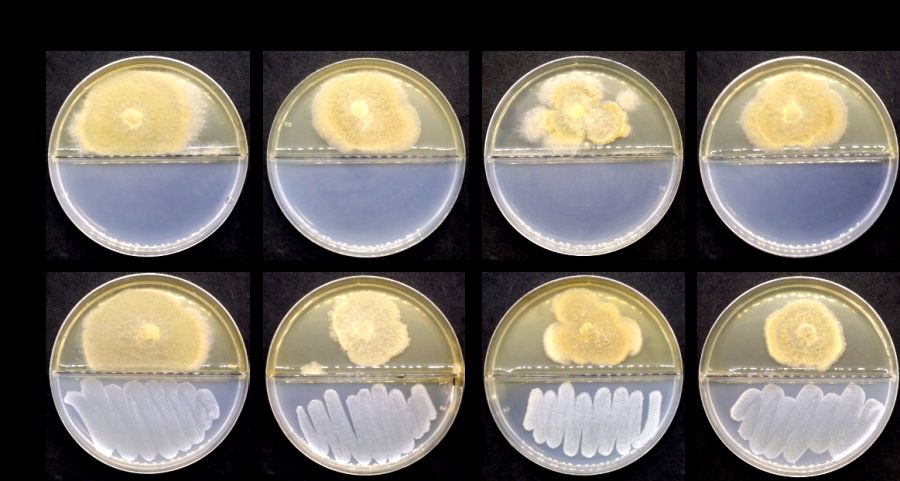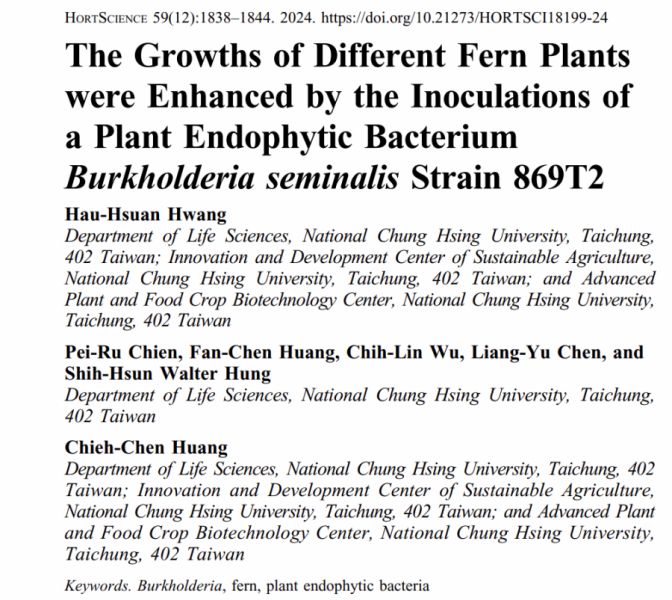循環農業:農業有機循環再利用的多合一創新碳匯技術開發【土壤環境科學系/楊秋忠院士】
| 論文篇名 | 英文:Hormesis of glyphosate on ferulic acid metabolism and antifungal volatile production in rice root biocontrol endophyte Burkholderia cepacia LS-044 中文:草甘膦對水稻根部生防內生菌洋蔥伯克氏菌LS-044阿魏酸代謝及抗真菌揮發物產生的毒效作用 |
| 期刊名稱 | CHEMOSPHERE |
| 發表年份,卷數,起迄頁數 | 2023; 345: 140511 |
| 作者 | Hameed, Asif; Nguyễn, Duc Hai; Lin, Shih-Yao; Stothard, Paul; Neelakandan, Poovarasan; Young, Li-Sen; Young, Chiu-Chung(楊秋忠)* |
| DOI | 10.1016/j.chemosphere.2023.140511 |
| 英文摘要 | Glyphosate (GP, N-phosphonomethyl glycine) is one of the most popular organophosphate herbicides, widely used in agricultural practices worldwide. There have been extensive reports on the biohazard attributes of GP, as well as on the hormetic impacts of this herbicide on plant and animal systems. However, the effects of GP on plant growth-promoting microbes and its ecological relevance remain unknown. Here we show that GP does exert a hormetic impact on Burkholderia cepacia LS-044, a rice (Oryza sativa ssp. japonica cv. Tainung 71) root endophytic isolate. We used increasing doses of ferulic acid (FA, 1‒25 mM) and GP (0.5‒5 mM) to test the growth and antifungal volatile production in LS-044 by electrochemical, liquid chromatographic, gas chromatographic and spectrophotometric means. GP treatment at a low dose (0.5 mM) increased the FA utilization and significantly (P < 0.0001) enhanced antifungal volatile production in LS-044. Although FA (1 mM) was rapidly utilized by LS-044, no chromatographically detectable utilization of GP was observed at tested doses (0.5‒5 mM). LS-044 emitted predominant amounts of tropone in addition to moderate-to-minor amounts of diverse ketones and/or their derivatives (acetone, acetophenone, 2-butanone, 1-propanone, 1-(2-furanyl-ethanone, 1-phenyl-1-propanone and 1-(3-pyridinyl)-1-propanone), d-menthol, 2-methoxy-3-(1-methylethyl)-pyrazine, dimethyl disulphide, pyridine and ammonium carbamate when grown under GP supplement. Genes involved in the transformation of FA, and a key gene encoding 5-enolpyruvylshikimate 3-phosphate synthase (EPSPS) with Gly-94 and Tyr-95 residues localized at active site most likely rendering EPSPS sensitivity to GP, were detected in LS-044. This is the first report of GP hormesis on a bacterium facilitating FA utilization and modulation of volatile fungicide production that have broad ecological implications. |
| 發表成果與本中心研究主題相關性 | 本研究描述一株水稻內生伯克氏菌LS-044對於廣泛應用於全球農業且最受歡迎的有機磷酸酯除草劑-草甘膦(GP,N-phosphonomethyl glycine)具有毒物興奮作用。經由遞增劑量的阿魏酸(FA,1-25 mM)和GP(0.5-5 mM),以電化學、液相層析、氣相層析和分光光度法測試LS-044 的生長和抗真菌揮發物的產生。伯克氏菌LS-044 在低劑量(≤ 1 mM) 草甘膦存在下表現出改變的表型和代謝特徵,包括細胞形態、阿魏酸利用和殺菌VOC 產生,表明除草劑具有興奮作用。草甘膦處理的LS-044 釋放的VOC 顯著促進了TN11 中的根部生長,但沒有促進TN71 中的根部生長,這表明對水稻植株表型具有潛在的毒物興奮效應,該影響隨水稻基因型的不同而變化。GP 的毒物興奮效應歸因於位於 EPSPS 活性位點的共存 Gly-94 和 Tyr-95 殘基,可增強細胞對草甘膦的敏感性。這是關於促進FA 利用和調節揮發性殺菌劑生產的細菌的GP 毒物興奮效應的第一份報告,具有廣泛的生態影響。 |







